German Shepherds are loyal, intelligent, and beautiful dogs, but they are also prone to a condition called hip dysplasia. This condition can cause discomfort, pain, and mobility issues, making it challenging for owners to provide proper grooming.
Many pet owners worry about how to groom their German Shepherd with hip dysplasia without causing further pain or stress.
Fortunately, there are effective solutions to ensure your German Shepherd remains well-groomed while managing hip dysplasia. By using gentle techniques, selecting the right grooming tools, and creating a comfortable environment, you can maintain your dog’s hygiene and comfort during hip dysplasia.
In this article, you’ll discover practical tips and methods to groom your German Shepherd with hip dysplasia safely and effectively.
Read on to learn everything you need to know about grooming your German Shepherd during hip dysplasia.
Contents
- 1 Understanding Hip Dysplasia In German Shepherds
- 2 Preparing For Grooming Your German Shepherd With Hip Dysplasia
- 3 Brushing The German Shepherd With Hip Dysplasia
- 4 Bathing And Drying Your German Shepherd
- 5 Nail Trimming and Paw Care
- 6 Maintaining Oral Hygiene
- 7 Activities To Avoid For Your German Shepherd With Hip Dysplasia
- 8 Should You Massage Your German Shepherd With Hip Dysplasia?
- 9 Conclusion:
- 10 Frequently Asked Questions:
- 10.1 How often should I groom my German Shepherd with hip dysplasia?
- 10.2 How can I help my German Shepherd with hip dysplasia?
- 10.3 How to make German Shepherds‘ back legs stronger?
- 10.4 How to groom a German Shepherd with elbow dysplasia?
- 10.5 How to treat hip dysplasia in German Shepherds?
- 10.6 How do I help prevent hip dysplasia in my German Shepherd?
- 11 Resources Used For Research:
Understanding Hip Dysplasia In German Shepherds
1. What is Hip Dysplasia?
Hip dysplasia is a genetic condition that affects the hip joints of dogs, particularly large breeds like German Shepherds.
It occurs when the hip joint doesn’t develop properly, leading to instability and degeneration over time.
This condition can cause significant pain and mobility issues, making everyday activities, including grooming, challenging for your dog.
According to the Orthopedic Foundation for Animals, about 19% of German Shepherds develop hip dysplasia. The severity of this condition can vary significantly, ranging from mild to severe.
2. Recognizing the Symptoms:
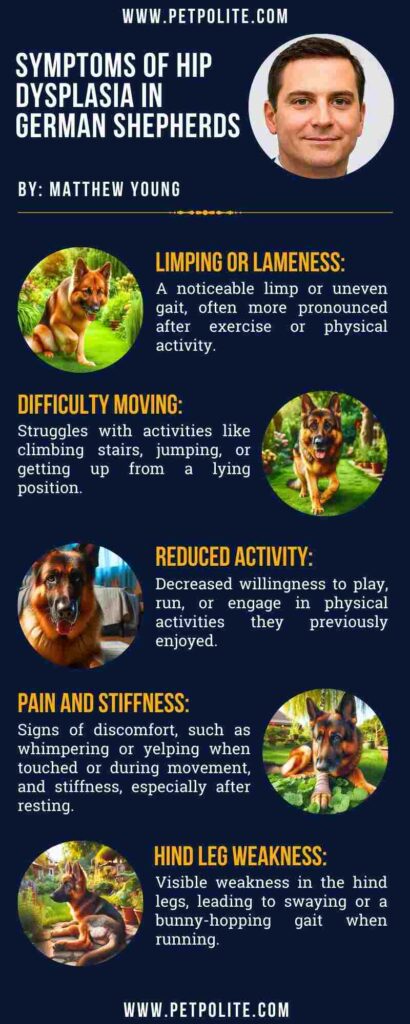
Here are the symptoms of hip dysplasia in German Shepherds:
- Limping or stiffness:
- Decreased activity:
- Looseness in the joint:
- Decreased range of motion:
- Swollen joints:
- Arthritis:
- Difficulty standing up:
- Bunny hopping:

“German Shepherds with hip dysplasia often show signs of weakness and pain in their back legs. They may have trouble getting up from sitting or lying position.”
Source: VCA Animal Hospitals
3. Importance of Grooming during Hip Dysplasia:
Grooming your German Shepherd with hip dysplasia is crucial for maintaining their overall health and comfort.
Regular grooming helps you monitor their condition, ensuring no sores or skin issues develop due to limited mobility.
Gentle grooming techniques also provide relief, improving their quality of life and strengthening your bond with your beloved pet.
Preparing For Grooming Your German Shepherd With Hip Dysplasia
Proper preparation can make the grooming process smoother and less stressful. This includes gathering the right tools, creating a comfortable grooming environment, and relaxing your dog.
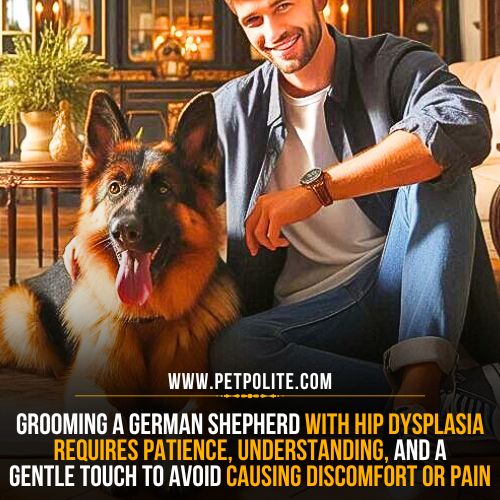

Here’s how you can do this:
1. Gathering the Right Tools:
To groom a German Shepherd with hip dysplasia, you’ll need a few specific tools:
- Soft-bristle brush or pin brush
- Slicker brush (for removing tangles and mats)
- Dog clippers (for trimming and shaving)
- Scissors (for trimming around eyes, ears, and paws)
- Nail clippers (for trimming nails)
- Grooming table or non-slip mat
2. Setting Up the Grooming Area:
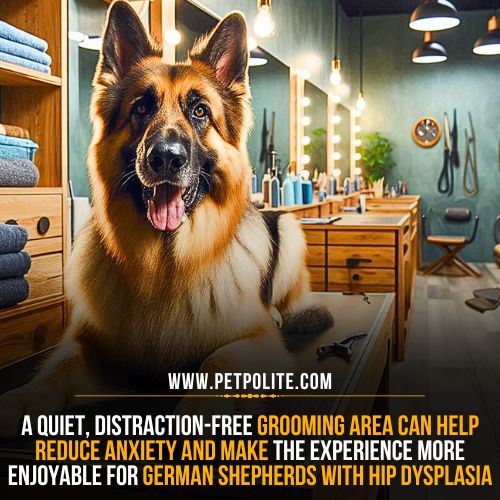

To groom a German Shepherd with hip dysplasia, start by creating a safe and comfortable grooming area.
Choose a quiet, non-slip surface where your dog can feel secure. You may want to use a padded mat or towel to provide extra comfort and support for their joints.
Ensure all grooming tools are within reach to minimize the time your dog needs to groom.
3. Using Supportive Equipment:
Investing in supportive equipment can make grooming easier and more comfortable for your dog.
Consider using a grooming table with an adjustable height to reduce the need for bending or awkward positions.
A grooming sling or harness can also help support your dog’s weight, reducing pressure on their hips.
4. Managing Anxiety and Stress:
Dogs with hip dysplasia may be more anxious during grooming sessions due to discomfort.
Use calming techniques such as soothing voices, gentle petting, and positive reinforcement to overcome these behavior issues during grooming.
Brushing The German Shepherd With Hip Dysplasia
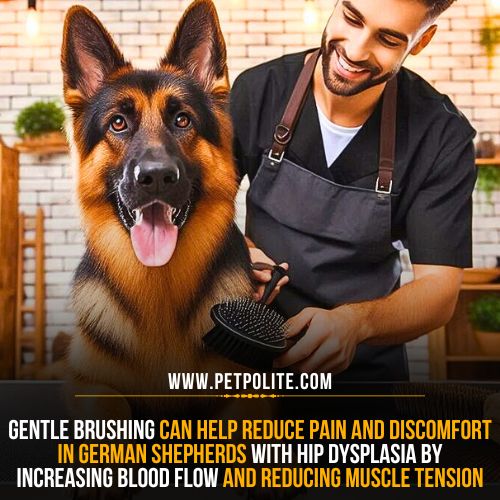

1. Choosing the Right Brush:
Selecting the appropriate brush is essential for grooming a German Shepherd with hip dysplasia.
A slicker brush or an undercoat rake can effectively remove loose fur and prevent matting without causing pain.
Be gentle and avoid applying excessive pressure, especially around the hip area.
2. Brushing Techniques:
Brush your dog in short, gentle strokes, starting from the head and working your way down to the tail.
Pay special attention to areas prone to matting, such as behind the ears and under the legs.
If you encounter any tangles, use a detangling spray and work them out gently with a comb.
3. Regular Brushing Schedule:
Aim to brush your dog at least 3-4 times a week, or more frequently during shedding seasons.
Regular brushing not only maintains the coat health of your GSD but also provides an opportunity to check for any changes in their skin or coat condition.
Bathing And Drying Your German Shepherd
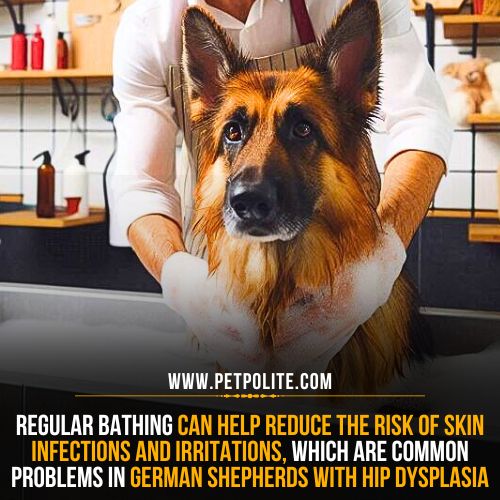

1. Preparing for the Bath:
Bathing a German Shepherd with hip dysplasia requires careful preparation to ensure your dog’s comfort and safety.
Use a non-slip mat in the bathtub or shower to prevent slipping.
Gather all necessary supplies, including dog-friendly shampoo, a cup for rinsing, and towels, before bringing your dog into the bathing area.
2. Bathing Techniques:
When bathing your dog, use lukewarm water and avoid getting water directly on their face.
Gently massage the shampoo into their coat, paying attention to areas that may be difficult to reach.
Be cautious around the hip area to avoid causing pain.
Rinse thoroughly to remove all shampoo, as residue can cause skin irritation.




“Bathe your pup gently with vet-approved shampoo, removing dirt and debris. Rinse thoroughly and consider having an assistant help keep them stable.”
Source: WagWalking.com
3. Drying Your Dog:
After the bath, gently pat your dog dry with a towel. Avoid vigorous rubbing, which can be uncomfortable for a dog with hip dysplasia.
If your dog tolerates it, use a blow dryer on a low, cool setting to dry their coat completely.
Nail Trimming and Paw Care
Nail trimming is one of the grooming challenges your German Shepherd might face. It helps prevent joint stress and ensures your dog can walk comfortably.
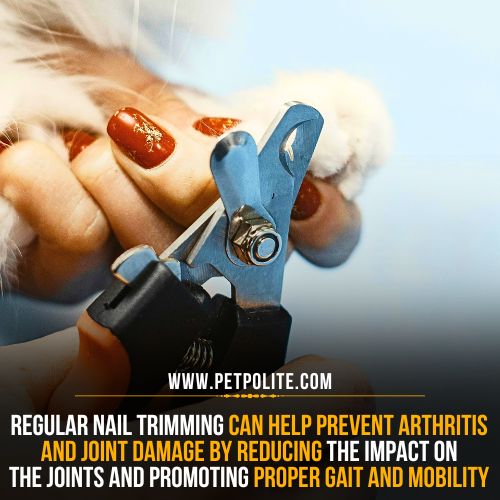

Here’s how you can perform these tasks:
1. Safe Nail Trimming Techniques:
Use a pair of dog-specific nail clippers or a grinder to trim your dog’s nails.
If your dog is uncomfortable with nail trimming, consider doing one or two nails at a time and using positive reinforcement to create a positive association with the process.
Be mindful of the quick, sensitive part of the nail that contains blood vessels, and trim only the tip of the nail to avoid causing pain.
2. Paw Pad Maintenance:
Regularly check your dog’s paw pads for any signs of injury or irritation. Keep the paw pads moisturized with a dog-safe balm to prevent cracking and dryness.
Clean between the toes to remove any dirt or debris that could cause discomfort.
Maintaining Oral Hygiene
Dental problems like abscesses, gum infections, or toothaches can cause chronic pain, which can radiate to other areas of the body, including the hips and joints, making hip dysplasia symptoms even worse.
Therefore, it becomes very crucial for you to maintain your German Shepherd’s oral hygiene.
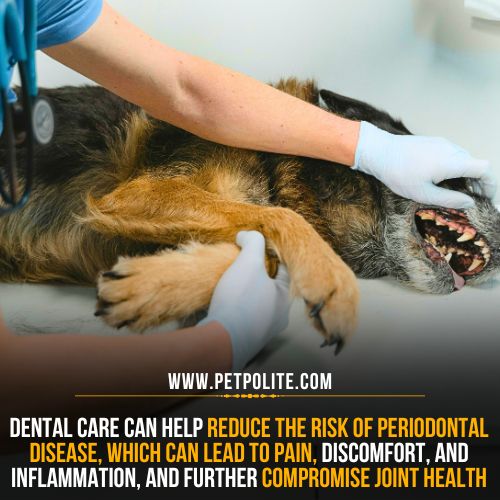

Here’s how you can do this with ease:
1. Brushing Your Dog’s Teeth:
Use a dog-specific toothbrush and toothpaste to brush your dog’s teeth regularly.
Start by allowing your dog to become familiar with the toothbrush and toothpaste.
Gradually work up to brushing their teeth, focusing on the gum line where plaque tends to accumulate.
Aim to brush your dog’s teeth at least 2-3 times a week.
2. Dental Chews and Treats:
In addition to brushing, dental chews and treats can help maintain your dog’s oral health.
Choose products designed to reduce plaque and tartar buildup.
Always supervise your dog when they are chewing to ensure they do not swallow large pieces.
Activities To Avoid For Your German Shepherd With Hip Dysplasia
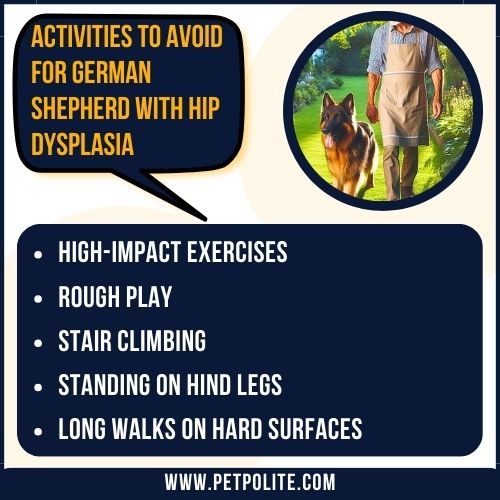

1. High-Impact Exercises:
High-impact exercises are particularly harmful to dogs with hip dysplasia. These activities can intensify joint pain and accelerate the progression of the condition.
i. Agility Training:
Agility courses typically involve jumping, weaving, and climbing, which are unsuitable for dogs with hip dysplasia.
These movements can cause significant joint stress and should be avoided.
ii. Running and Jumping:
Running and jumping involve sudden, high-impact movements that can put a lot of stress on the hip joints.
Avoid games like fetch or frisbee that require these actions.




“Limit your dog’s jumping activities, such as jumping on and off high furniture, beds, or couches, and avoid encouraging high-impact play to reduce stress on their joints.”
Source: WagWalking.com
2. Rough Play:
German Shepherds are often playful and energetic, but rough play can lead to accidental injuries or exacerbate existing hip issues.
Monitor playtime closely and intervene if it becomes too vigorous.
3. Stair Climbing:
Climbing stairs repeatedly can strain your dog’s hips. If your home has multiple levels, consider using baby gates to limit their access or assist them when navigating stairs.
4. Standing on Hind Legs:
Encouraging your dog to stand on their hind legs can be harmful, as this position:
- Places undue pressure on their hip joints
- This can lead to joint pain and discomfort
- May cause long-term damage to their joints
Therefore, avoid activities or training that require this posture.
5. Long Walks on Hard Surfaces:
Walking on hard surfaces like concrete can increase the impact on your dog’s hips.
Opt for shorter walks on softer surfaces such as grass or dirt paths to minimize joint stress.
Here is a list of activities to avoid or modify for German Shepherds with hip dysplasia:
| Activity | Reason to Avoid/Modify |
|---|---|
| High-Impact Exercises (e.g., jumping, running) | Puts excessive stress on joints |
| Stair Climbing | Increases strain on hip joints |
| Long Walks/Runs | Prolonged exercise can cause fatigue and pain |
| Sudden Stops/Starts | Sudden movements can jar the joints, causing pain |
| Playing on Hard Surfaces | Increases impact on joints, worsening hip dysplasia |
| Jumping from Heights | Increases impact on joints, worsening hip dysplasia |
| Tug-of-War | Twisting, and pulling motions can strain hip joints |
| Sudden Twists/Turns | Sudden movements can jar the joints, causing pain |
Should You Massage Your German Shepherd With Hip Dysplasia?
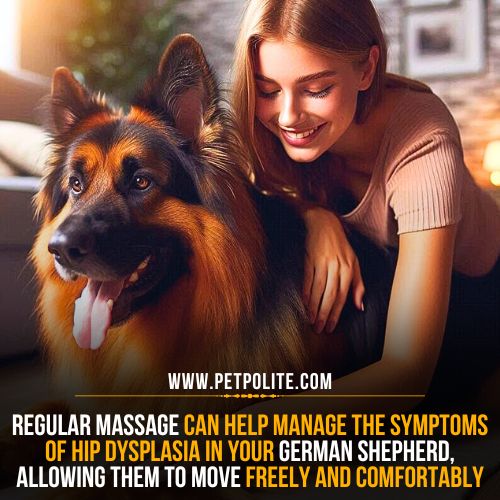

Massaging your German Shepherd with hip dysplasia can be highly beneficial.
Massage therapy helps alleviate pain, reduce inflammation, and improve blood circulation around the hip joints.
Regular massage sessions can also prevent muscle stiffness and enhance overall flexibility.
In addition to physical benefits, massage provides psychological comfort. The soothing touch can help reduce stress and anxiety, creating a calming experience for your dog.
When massaging your German Shepherd, focus on the muscles surrounding the hip area rather than the joint itself.
Use gentle, circular motions with your fingertips, and monitor your dog’s reactions to ensure they are comfortable.
If your dog shows signs of discomfort, reduce pressure or stop the massage.
Here’s a massage technique you can try for hip dysplasia in your German Shepherd:
Conclusion:
Grooming a German Shepherd with hip dysplasia requires patience, understanding, and a gentle approach.
By creating a safe and comfortable grooming environment, using supportive equipment, and employing gentle techniques, you can help your dog stay clean and comfortable without causing additional pain.
Regular brushing, careful bathing, nail trimming, and maintaining oral hygiene are all essential components of a comprehensive grooming routine.
With the right care and attention, you can ensure your German Shepherd remains healthy and happy despite their hip dysplasia.
Frequently Asked Questions:
How often should I groom my German Shepherd with hip dysplasia?
Groom your German Shepherd with hip dysplasia every 2-3 weeks, focusing on gentle brushing (3-4 times a week), nail trimming (every 2-3 weeks), teeth cleaning (2-3 times a week), and bathing (every 6-8 weeks or as needed).
How can I help my German Shepherd with hip dysplasia?
You can help your German Shepherd with hip dysplasia by providing a comfortable and supportive environment, managing their weight, and providing regular exercise and physical therapy.
How to make German Shepherds‘ back legs stronger?
You can strengthen your German Shepherd’s back legs by providing regular exercise, physical therapy, and a healthy weight. Use ramps or stairs to reduce jumping, and consider adding joint supplements to their diet.
How to groom a German Shepherd with elbow dysplasia?
Groom your German Shepherd with elbow dysplasia gently, using soft-bristle brushes and avoiding pressure on the affected area. Trim with caution, and consider raised grooming tables or non-slip mats for comfort.
How to treat hip dysplasia in German Shepherds?
Treat hip dysplasia in German Shepherds with weight management, exercise modification, and pain management medication. Consider physical therapy, surgery, or alternative therapies like acupuncture or massage.
How do I help prevent hip dysplasia in my German Shepherd?
Maintain a healthy weight and avoid excessive jumping or high-impact activities. Feed a balanced diet, consider adding joint supplements, and consult your veterinarian for genetic testing and screening. Early prevention can reduce the risk of hip dysplasia.
Resources Used For Research:
- The Demographics of Canine Hip Dysplasia in the United States and Canada – National Library of Medicine
- Novel protective and risk loci in hip dysplasia in German Shepherds – National Library of Medicine
- Heritability of hip dysplasia: Preliminary results for German Shepherd dogs in Brazil – Science Direct
- A review of hereditary diseases of the German shepherd dog – Science Direct
- Grooming Dogs: What’s Good and Bad From Their Point of View – Psychology Today